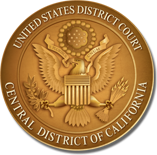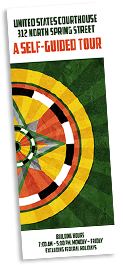The 1960s
The 1960s was a time of youth as baby boomers became teenagers and young adults. Movement away from the conservative Fifties resulted in revolutionary ways of thinking. Pop art and Op art uses of patterns and colors appeared on everything from furniture to clothing. Young people wanted change that affected values and lifestyles. At the courthouse, the 1960s started off with a bang. In August 1961, an unidentified caller claimed that seven bombs had been planted inside the Los Angeles federal building and would detonate in an hour. Over 2,000 employees evacuated the premises due to the scare. The threat turned out to be false, but U.S. District Judge Harry Westover had already dismissed his jury members as a result.
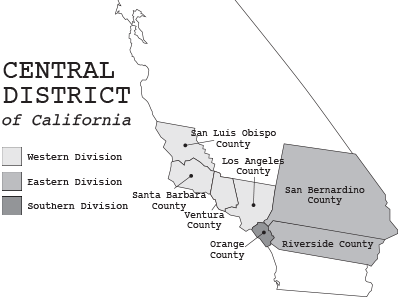 Change was everywhere in the Sixties, and the creation of new judicial districts was about to affect the District Court. Between 1938, when the Los Angeles federal building opened, and 1966, the U.S. District Court for the Southern District of California grew from six to twenty-four district judges. With the state still growing, California was further subdivided into four federal judicial districts. The Eastern and Central Districts were created in 1966, and Los Angeles was absorbed by the Central District. Ten Southern District judges transferred to the new Central District and three additional judgeships were authorized, and the new district’s seal of the court was officially adopted on September 19, 1966. The newly created Central District encompassed seven counties and was larger than New Hampshire, Massachusetts, New Jersey, Hawaii, Connecticut, Delaware, and Rhode Island combined.
Change was everywhere in the Sixties, and the creation of new judicial districts was about to affect the District Court. Between 1938, when the Los Angeles federal building opened, and 1966, the U.S. District Court for the Southern District of California grew from six to twenty-four district judges. With the state still growing, California was further subdivided into four federal judicial districts. The Eastern and Central Districts were created in 1966, and Los Angeles was absorbed by the Central District. Ten Southern District judges transferred to the new Central District and three additional judgeships were authorized, and the new district’s seal of the court was officially adopted on September 19, 1966. The newly created Central District encompassed seven counties and was larger than New Hampshire, Massachusetts, New Jersey, Hawaii, Connecticut, Delaware, and Rhode Island combined.
 When the federal building, which included a post office, officially opened in 1939, murals decorated both the ceiling and lobby walls. In the 1960s, the post office was removed to accommodate more courtrooms. At that time, the murals were removed and put in storage in the basement. After more than thirty years, three murals were reinstalled in the courthouse. In 1965, artist Edward Biberman watched the removal of his mural titled “Los Angeles – Prehistoric and Spanish Colonial,” which was relocated to the Spring Street lobby of the Los Angeles federal courthouse in 2003. The murals were not the only decorative flourishes at the federal building. To remind taxpayers to file their taxes during the 1961 and 1962 tax seasons, the Internal Revenue Service lit various reminders such as “File Early” and “File Now” on the side of the Los Angeles federal building. On April sixteenth, the day after the filing deadline, the final message read “Thank You.”
When the federal building, which included a post office, officially opened in 1939, murals decorated both the ceiling and lobby walls. In the 1960s, the post office was removed to accommodate more courtrooms. At that time, the murals were removed and put in storage in the basement. After more than thirty years, three murals were reinstalled in the courthouse. In 1965, artist Edward Biberman watched the removal of his mural titled “Los Angeles – Prehistoric and Spanish Colonial,” which was relocated to the Spring Street lobby of the Los Angeles federal courthouse in 2003. The murals were not the only decorative flourishes at the federal building. To remind taxpayers to file their taxes during the 1961 and 1962 tax seasons, the Internal Revenue Service lit various reminders such as “File Early” and “File Now” on the side of the Los Angeles federal building. On April sixteenth, the day after the filing deadline, the final message read “Thank You.”
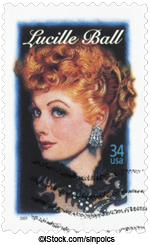 The court also heard many significant cases during the 1960s. In 1967, Lavada Daugherty, a Desilu shareholder, brought an action in federal court (Daugherty v. Ball) seeking recovery on behalf of the corporation for alleged overpayment of executive compensation to Lucille Ball, President of Desilu from 1963 through 1965. After the complaint was filed, the assets of the corporation were acquired by Gulf+Western, which then merged Desilu with Paramount Pictures to create Paramount Television. U.S. District Judge Andrew A. Hauk held that all derivative claims were moot because of the merger, and the case was dismissed.
The court also heard many significant cases during the 1960s. In 1967, Lavada Daugherty, a Desilu shareholder, brought an action in federal court (Daugherty v. Ball) seeking recovery on behalf of the corporation for alleged overpayment of executive compensation to Lucille Ball, President of Desilu from 1963 through 1965. After the complaint was filed, the assets of the corporation were acquired by Gulf+Western, which then merged Desilu with Paramount Pictures to create Paramount Television. U.S. District Judge Andrew A. Hauk held that all derivative claims were moot because of the merger, and the case was dismissed.
That same year, Herbert Manfred “Zeppo” Marx, the youngest of the Marx Brothers, testified during the Friars Club Investigation. Marx, an actor, comedian, theatrical agent, and engineer, appeared in the first five Marx Brothers movies. He was one of eight witnesses who testified before the grand jury about card losses at the Friars Club in Beverly Hills, which was run by Miami electronics engineer Edwin Gebhard. Gebhard was later tried for his part in using electronic devices and other methods to help gamblers cheat in card games held at the club.
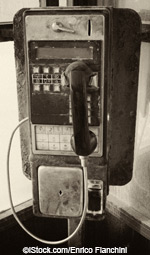 Another case involving gambling was heard by U.S. District Judge Jesse W. Curtis in 1965. Charles Katz was convicted of conducting illegal gambling operations across state lines in violation of federal law. In order to convict Katz, federal agents had a warrantless wiretap placed in the public telephone booth he used for these operations. Two years later, in Katz v. United States, Katz petitioned the U.S. Supreme Court, claiming the warrantless wiretapping of a public phone booth was an unreasonable search of a constitutionally protected area in violation of the Fourth Amendment. The Supreme Court agreed with Katz and the evidence gathered against him was suppressed.
Another case involving gambling was heard by U.S. District Judge Jesse W. Curtis in 1965. Charles Katz was convicted of conducting illegal gambling operations across state lines in violation of federal law. In order to convict Katz, federal agents had a warrantless wiretap placed in the public telephone booth he used for these operations. Two years later, in Katz v. United States, Katz petitioned the U.S. Supreme Court, claiming the warrantless wiretapping of a public phone booth was an unreasonable search of a constitutionally protected area in violation of the Fourth Amendment. The Supreme Court agreed with Katz and the evidence gathered against him was suppressed.
Two years earlier, Frank Sinatra’s son, Frank Sinatra, Jr., appeared at his kidnapping trial. On December 8, 1963, the younger Sinatra was abducted from Harrah’s Lodge in Lake Tahoe and held for ransom. Frank Sinatra, Sr. paid $240,000 for his son’s release. During the three kidnappers’ trial, the defense suggested that Sinatra, Jr. planned his own kidnaping as a publicity stunt, which was adamantly denied by father and son. Sinatra, Jr. testified he was “playing it cool” rather than attempting to escape. U.S. District Judge William G. East, from the U.S. District Court in Portland, Oregon, had already been assisting the Los Angeles federal court when he was hand-selected by Chief Judge Peirson Hall to preside over the trial.
 The 1960s brought about the Vietnam War, and protests against the war occurred at government buildings and college campuses across the nation. In 1966, protesters held a rally at the Los Angeles federal building bearing signs calling for the end of the Vietnam War, which lasted from approximately 1954 until 1975. In addition to anti-war protests, people protested domestic issues in the 1960s. On March 7, 1965, 600 African American marchers set out from Selma, Alabama to the capitol in Montgomery calling for equal voting rights. Alabama state troopers and a sheriff’s posse attacked the unarmed marchers just outside of Selma in what would be known as “Bloody Sunday.” Images and accounts of the attack shook the nation. Two days later, members of the Congress of Racial Equality (CORE) protested against the violence in Selma inside the Los Angeles federal building. News photos show CORE members being dragged out of the lobby by U.S. Marshals.
The 1960s brought about the Vietnam War, and protests against the war occurred at government buildings and college campuses across the nation. In 1966, protesters held a rally at the Los Angeles federal building bearing signs calling for the end of the Vietnam War, which lasted from approximately 1954 until 1975. In addition to anti-war protests, people protested domestic issues in the 1960s. On March 7, 1965, 600 African American marchers set out from Selma, Alabama to the capitol in Montgomery calling for equal voting rights. Alabama state troopers and a sheriff’s posse attacked the unarmed marchers just outside of Selma in what would be known as “Bloody Sunday.” Images and accounts of the attack shook the nation. Two days later, members of the Congress of Racial Equality (CORE) protested against the violence in Selma inside the Los Angeles federal building. News photos show CORE members being dragged out of the lobby by U.S. Marshals.
